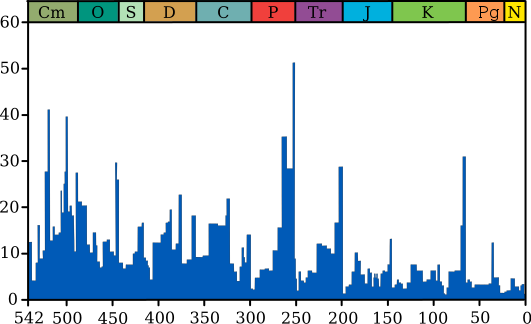 |
What Did The Mass Extinctions |
In this series I will focus on the genes of the Coronaviradae, of which it is said:
"Coronaviruses (CoVs) are a highly diverse family of enveloped positive- sense single- stranded RNA viruses. They infect humans, other mammals and avian species, including livestock and companion animals, and are therefore not only a challenge for public health but also a veterinary and economic concern ... Human coronaviruses ... have long been known to circulate in the population and they, together with the more recently identified HCoV- NL63 and HCoV- HKU1, cause seasonal and usually mild respiratory tract infections associated with symptoms of the ‘common cold’. In strong contrast, severe acute respiratory syndrome coronavirus (SARS-CoV) ... and SARS-CoV-2, which have emerged in the human population over the past 20 years, are highly pathogenic."
(Coronavirus biology and replication, (from 30K' above) emphasis added). Before the Trump Administration, not many of us had even heard of that 'family'.
In a previous series I focused mainly on the segments of the Coronaviradae genome, but now I will focus on the genes and how they have and perhaps still are being changed by the microbe host or hosts of Coronaviradae.
But first, for perspective, let's expose some myths that are being spread by loose lips in the media.
For starters, viruses do not replicate or reproduce themselves (Virus replication), nor are they alive (Viruses and the Tree of Life).
They are replicated or reproduced inside the machinery of microbes (ibid).
They do not take over the machinery of microbes, such as the ribosome, instead they are managed my that machinery.
That microbial machinery reproduces the microbe's genome as well as all the other genomes inside that microbe (The Proto-Ribosome).
It is what they naturally do.
More on all of that as we proceed through the universe of microbes and Coronaviradae viruses in terms of genes.
Soon, hopefully tomorrow, I will reveal my sources which you can download for your own use if you so choose.
But I suggest that you come to grips with the universe we are going to explore by reviewing some Dredd Blog history (e.g. On The Origin of the Genes of Viruses) and watching a couple of videos below about the languages they speak, and the vastness of that universe:
 |
| Microbes |
Video Index (time - subject)
00:21 - microbes are oldest life forms on Earth
01:03 - 10 times more microbes than human cells in us
01:31 - 100 times more microbial genes than human genes in us
02:00 - microbes are 99% of our make-up; they keep us alive
02:20 - microbes are vital for keeping us alive and healthy
04:20 - microbes talk with a molecular language
07:50 - quorum sensing (like a census) to know population count
08:20 - Intra species communication (shape of words) dialects
10:50 - microbes communicate with other microbes (multi-lingual)
11:20 - they take a census of all other microbes around them
12:30 - synthetic molecules-words interrupt communication
13:50 - synthetic molecules-words confuse the microbes
15:00 - they have collective, community behaviors
15:20 - microbes made the rules for multi-cellular development
16:00 - microbes invented multi-cellular behavior inside us
17:15 - the team
Dr. Bonnie L. Bassler, Princeton University:
What viruses go through when they enter a microbe:
The next post in this series is here.